Related Research Articles

Bucharest is the capital and largest city of Romania. The metropolis stands on the River Dâmbovița in south-eastern Romania. Its population is officially estimated at 1.76 million residents within a greater metropolitan area of 2.3 million residents, which makes Bucharest the 8th most-populous city in the European Union. The city area measures 240 km2 (93 sq mi) and comprises 6 districts (Sectoare), while the metropolitan area covers 1,811 km2 (699 sq mi). Bucharest is a beta global city, a major cultural, political and economic hub, and the country's seat of government.
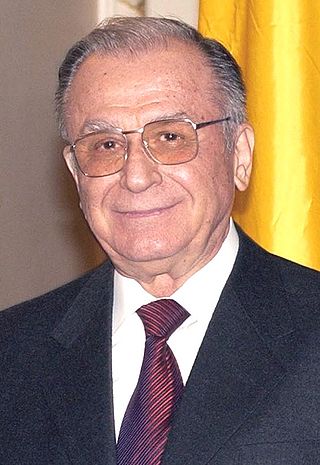
Ion Iliescu is a Romanian politician and engineer who served as the first and third president of Romania from 1989 until 1996 and from 2000 until 2004. Between 1996 and 2000 and also from 2004 to 2008, the year in which he retired, Iliescu was a senator for the Social Democratic Party (PSD), of which he is the founder and honorary president to this day.
After the Communist rulership ended and the former Communist dictator Nicolae Ceaușescu was executed in the midst of the bloody Romanian Revolution of December 1989, the National Salvation Front (FSN) seized power, led by Ion Iliescu. The FSN transformed itself into a massive political party in short time and overwhelmingly won the general election of May 1990, with Iliescu as president. These first months of 1990 were marked by violent protests and counter-protests, involving most notably the tremendously violent and brutal coal miners of the Jiu Valley which were called by Iliescu himself and the FSN to crush peaceful protesters in the University Square in Bucharest.

The Romanian revolution was a period of violent civil unrest in Romania during December 1989 as a part of the revolutions of 1989 that occurred in several countries around the world, primarily within the Eastern Bloc. The Romanian revolution started in the city of Timișoara and soon spread throughout the country, ultimately culminating in the drumhead trial and execution of longtime Romanian Communist Party (PCR) General Secretary Nicolae Ceaușescu and his wife Elena, and the end of 42 years of Communist rule in Romania. It was also the last removal of a Marxist–Leninist government in a Warsaw Pact country during the events of 1989, and the only one that violently overthrew a country's leadership and executed its leader; according to estimates, over one thousand people died and thousands more were injured.
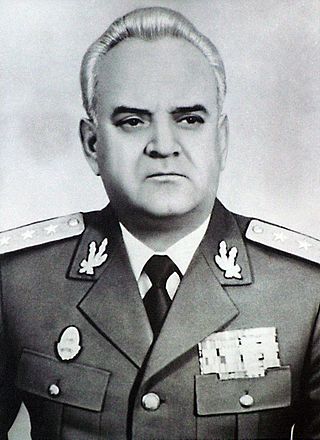
Vasile Milea was a Romanian politician and general who was Nicolae Ceaușescu's Minister of Defence during the Romanian Revolution of 1989 and was involved in the reprisal phase of the Revolution that caused the deaths of 162 people.

The Memorial of Rebirth is a memorial in Bucharest, Romania that commemorates the struggles and victims of the Romanian Revolution of 1989, which overthrew Communism. The memorial complex was inaugurated in August 2005 in Revolution Square, where Romania's Communist-era dictator, Nicolae Ceaușescu, was publicly overthrown in December 1989.

Teoctist was the Patriarch of the Romanian Orthodox Church from 1986 to 2007.

There is relatively little history of active practice of Hinduism in Romania, although many prominent Romanian thinkers have had an interest in Hindu thought, and since the Romanian Revolution of 1989 there have been some converts through the work of International Society for Krishna Consciousness. Hare Krishna devotee provide free food for life program and other cultural festivals around the country. Every year Hare Krishna devotee organise Rath Yatra of Lord Jagganath and thousands of people participate in the Rath Yatra.
Anneli Ute Gabanyi is a German political scientist, literary critic, journalist, and philologist of Romanian background, especially known for her research on the society and culture of the Cold War period in Romania and the Romanian Revolution of 1989. A former main analyst for Südost-Institut in Munich, she is an associate researcher for the German Institute for International and Security Issues in Berlin.

12:08 East of Bucharest is a 2006 Romanian film directed by Corneliu Porumboiu, released in 2006 and winner of the Caméra d'Or Prize at the Cannes Film Festival. It was also released in the United States under the abridged titles East of Bucharest and 12:08 Bucharest. The film is set in a small Romanian town far away from the capital city of Bucharest, and centers on a group of characters who revisit the Romanian Revolution of 1989 which brought an end to the communist regime.
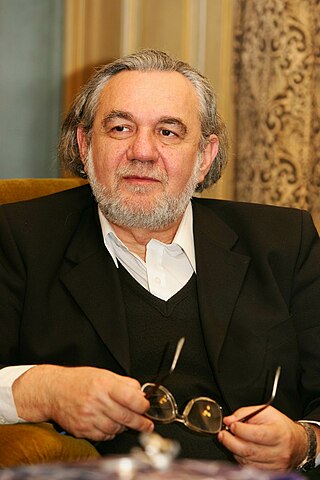
Andrei Oișteanu is a Romanian historian of religions and mentalities, ethnologist, cultural anthropologist, literary critic and novelist. Specialized in the history of religions and mentalities, he is also noted for his investigation of rituals and magic and his work in Jewish studies and the history of antisemitism. After the Romanian Revolution of 1989, he also became noted for his articles and essays on the Holocaust in Romania.
Romanian architecture is very diverse, including medieval, pre-World War I, interwar, postwar, and contemporary 21st century architecture. In Romania, there are also regional differences with regard to architectural styles. Architecture, as the rest of the arts, was highly influenced by the socio-economic context and by the historical situation. For example, during the reign of King Carol I (1866–1914), Romania was in a continuous state of reorganization and modernization. In consequence, most of the architecture was designed by architects trained in Western European academies, particularly the École des Beaux-Arts, and a big part of the downtowns of the Romanian Old Kingdom were built during this period.

The diplomatic relations between the Portuguese Republic and Romania date back to 1917, having been interrupted following World War II, before being re-established in June 1974, following the Carnation Revolution in Portugal. Since then, the relations between the two countries have been stable and friendly. Both nations are members of the Council of Europe, European Union, NATO and the United Nations.

Romania–Spain relations are the bilateral relations between Romania and the Kingdom of Spain. Both nations are members of the Council of Europe, European Union, NATO and the United Nations. Spain has given full support to Romania's membership in the European Union and NATO.

Norway–Romania relations are foreign relations between Norway and Romania. Both countries established diplomatic relations on April 3, 1917. Norway has an embassy in Bucharest and an honorary consulate in Constanţa. Romania has an embassy in Oslo and 4 honorary consulates.
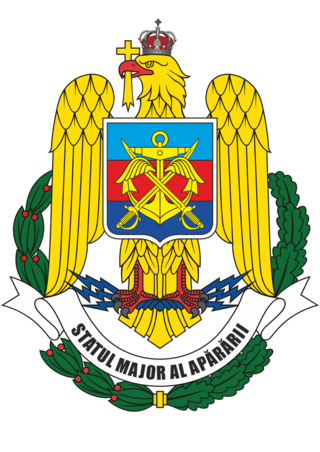
The Romanian Armed Forces are the military forces of Romania. It comprises the Land Forces, the Naval Forces and the Air Force. The current Commander-in-chief is Lieutenant General Gheorghiță Vlad who is managed by the Minister of National Defence while the president is the Supreme Commander of the Armed Forces during wartime.

The Armistice of Focșani was an agreement that ended the hostilities between Romania and the Central Powers in World War I. It was signed on 9 December 1917 in Focșani in Romania.
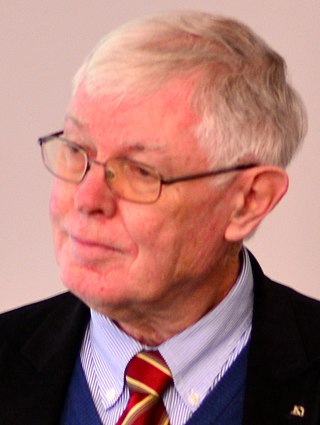
Dennis Deletant is a British-Romanian historian of the history of Romania. As of 2019, he is Visiting Ion Rațiu Professor of Romanian Studies at Georgetown University and Emeritus Professor of Romanian Studies at the UCL School of Slavonic and East European Studies (SSEES). He is the author of numerous works on the history of Romania including Ceaușescu and the Securitate: Coercion and Dissent in Romania, 1965-89 ; Romania under Communist Rule ; Communist Terror in Romania: Gheorghiu-Dej and the Police State, 1948-1965 ; and Ion Antonescu: Hitler's Forgotten Ally.

Romanian Revival architecture is an architectural style that has appeared in the late 19th century in Romanian Art Nouveau, initially being the result of the attempts of finding a specific Romanian architectural style. The attempts are mainly due to the architects Ion Mincu (1852–1912), and Ion N. Socolescu (1856–1924). The peak of the style was the interwar period. The style was a national reaction after the domination of French-inspired Classicist Eclecticism. Apart from foreign influences, the contribution of Romanian architects, who reinvented the tradition, creating, at the same time, an original style, is manifesting more and more strongly. Ion Mincu and his successors, Grigore Cerchez, Cristofi Cerchez, Petre Antonescu, or Nicolae Ghica-Budești declared themselves for a modern architecture, with Romanian specific, based on theses such as those formulated by Alexandru Odobescu around 1870:
"Study the remains – no matter how small – of the artistic production of the past and make them the source of a great art (...) do not miss any opportunity to use the artistic elements presented by the Romanian monuments left over from old times; but transform them, change them, develop them ..."
Events from the year 1944 in Romania. The year was dominated by the Second World War. The year started with the Soviet Army assault on Romanian troops and the Battle of Romania. King Michael led a coup d'état during the year and Romania left the Axis powers and joined the Allies. The Romanian army subsequently won victories against German and Hungarian troops.